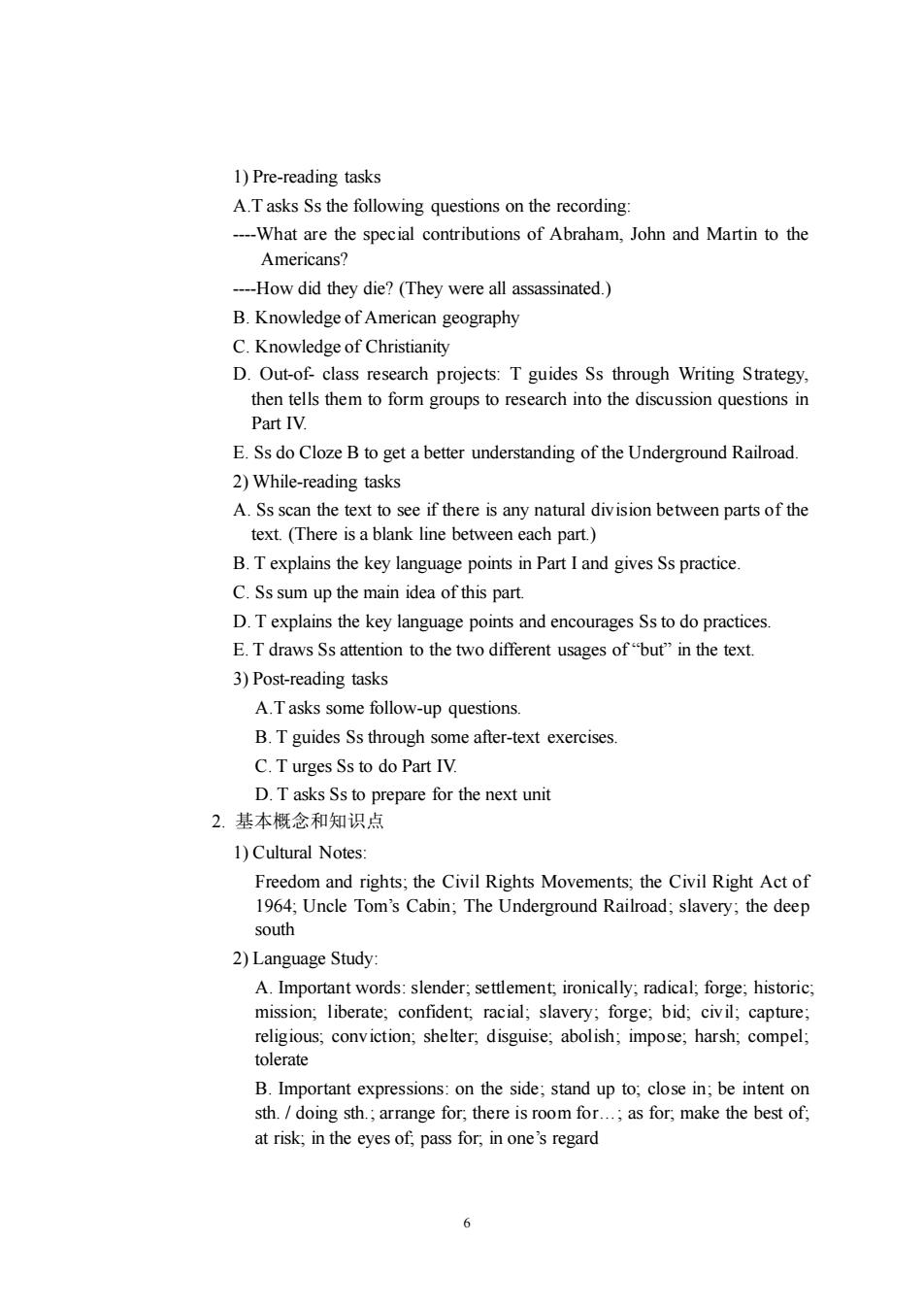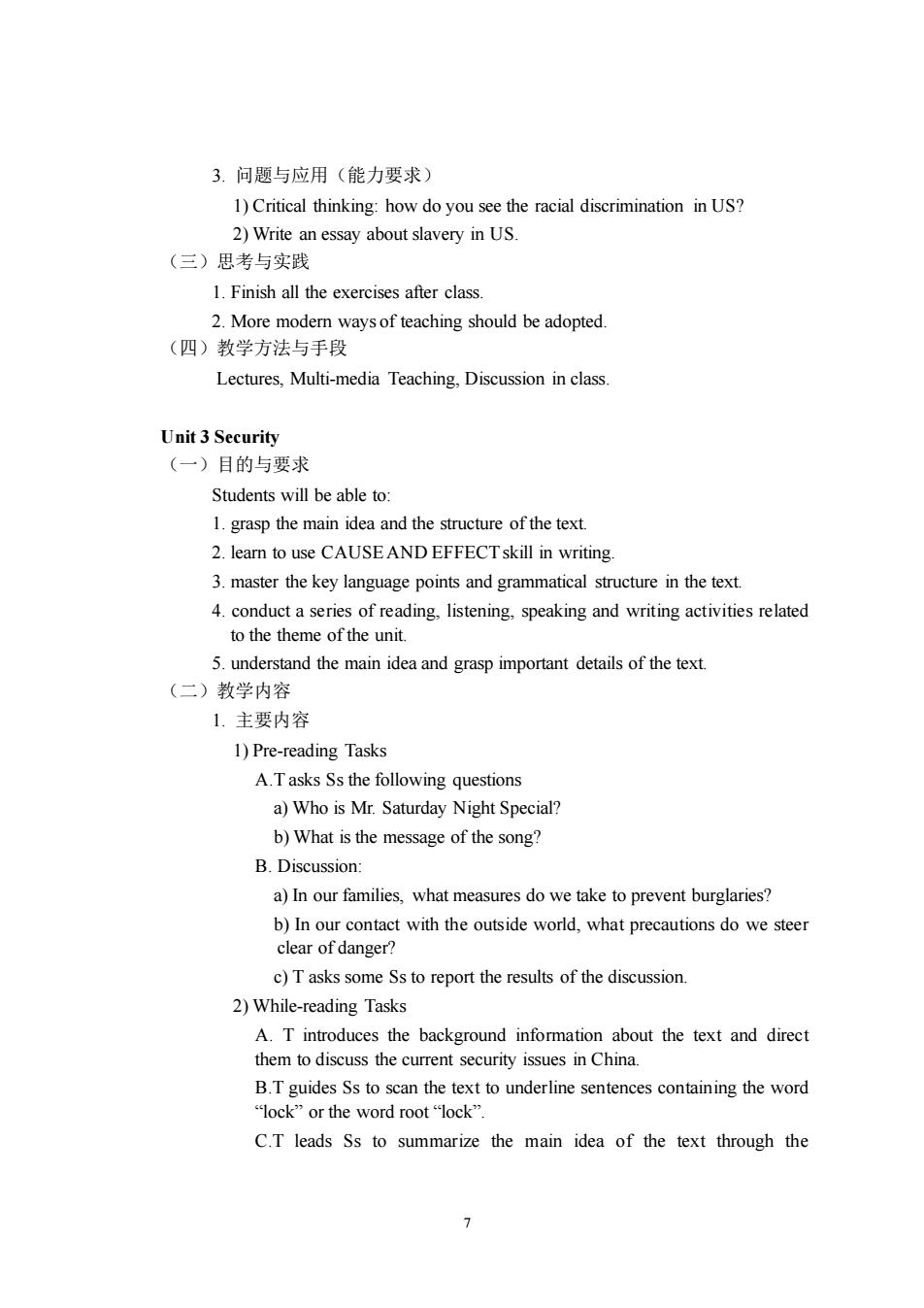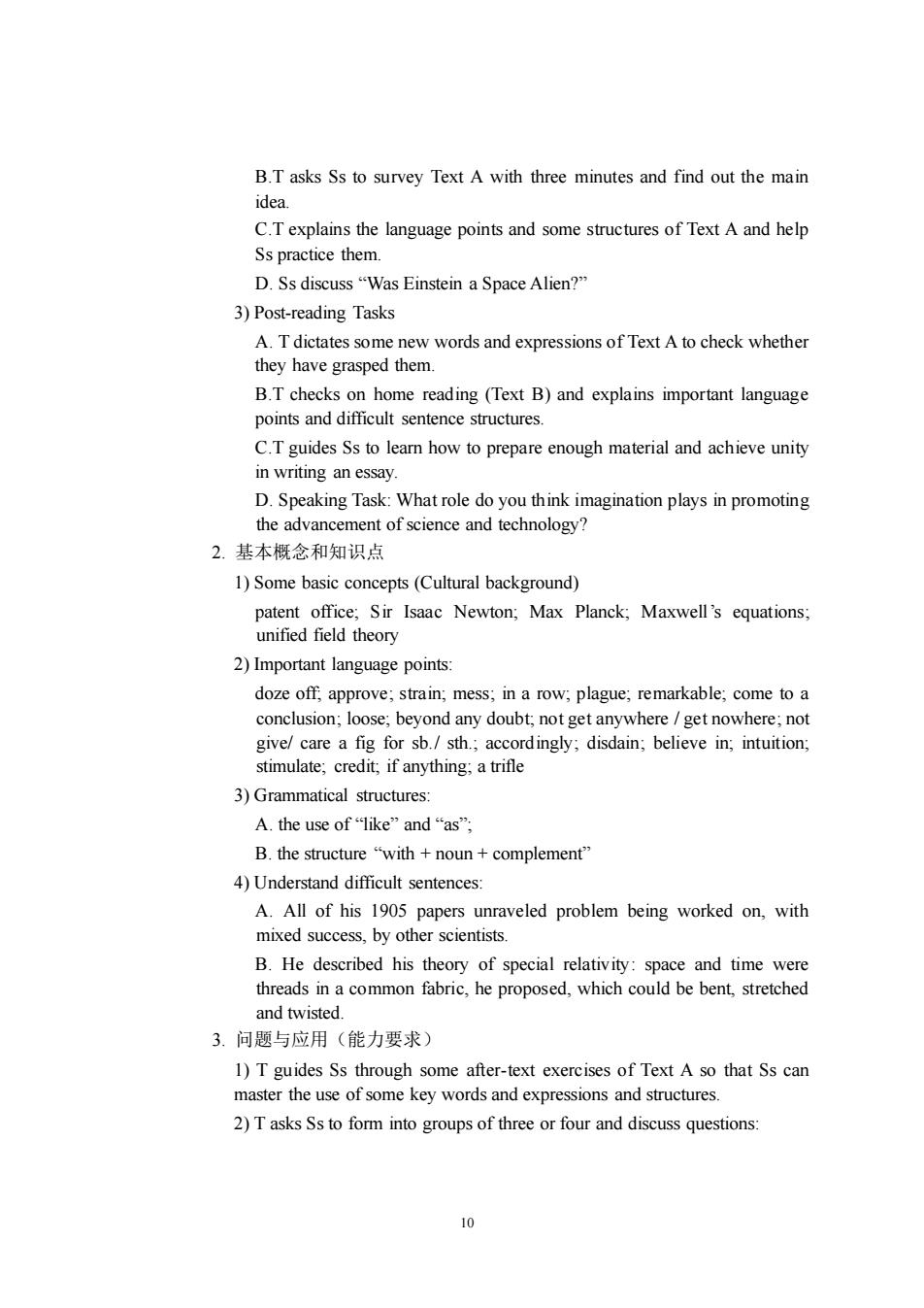
1)Pre-reading tasks A.Tasks Ss the following questions on the recording: ---What are the special contributions of Abraham,John and Martin to the Americans? ----How did they die?(They were all assassinated. B.Knowledge of American geography C.Knowledge of Christianity D.Out-of-class research projects:T guides Ss through Writing Strategy then tells them to form groups to research into the discussion questions in Part IV E.Ss do Cloze B to get a better understanding of the Underground Railroad 2)While-reading tasks A.Ss scan the text to see if there is any natural division between parts of the text.(There is a blank line between each part B.T explains the key language points in Part I and gives Ss practice. C.Ss sum up the main idea of this part D.T explains the key language points and encourages Ss to do practices. E.Tdraws Ss attention to the two different usages of"but"in the text. 3)Post-reading tasks A.Tasks some follow-up questions. B.Tguides Ss through some after-text exercises. C.T urges Ss to do Part IV. D.Tasks Ss to prepare for the next unit 2.基本概念和知识点 1)Cultural Notes: Freedom and Civil Rights Movements the Civil Right Act of Uncle Tom's Cabin;The Underground Railroad slavery;the deep south 2)Language Study A.Important words:slender;settlement,ironically;radical;forge:historic; mission;liberate;confident racial;slavery;forge;bid;civil;capture; religious,conviction,shelter,disguise,abolish;impose;harsh;compel; tolerate B.Important expressions:on the side;stand up to;close in;be intent on sth.doing sth.;arrange for,there is room for...;as for,make the best of; at risk:in the eyes of pass for,in one's regard 6
6 1) Pre-reading tasks A.T asks Ss the following questions on the recording: ----What are the special contributions of Abraham, John and Martin to the Americans? ----How did they die? (They were all assassinated.) B. Knowledge of American geography C. Knowledge of Christianity D. Out-of- class research projects: T guides Ss through Writing Strategy, then tells them to form groups to research into the discussion questions in Part IV. E. Ss do Cloze B to get a better understanding of the Underground Railroad. 2) While-reading tasks A. Ss scan the text to see if there is any natural division between parts of the text. (There is a blank line between each part.) B. T explains the key language points in Part I and gives Ss practice. C. Ss sum up the main idea of this part. D. T explains the key language points and encourages Ss to do practices. E. T draws Ss attention to the two different usages of “but” in the text. 3) Post-reading tasks A.T asks some follow-up questions. B. T guides Ss through some after-text exercises. C. T urges Ss to do Part IV. D. T asks Ss to prepare for the next unit 2. 基本概念和知识点 1) Cultural Notes: Freedom and rights; the Civil Rights Movements; the Civil Right Act of 1964; Uncle Tom’s Cabin; The Underground Railroad; slavery; the deep south 2) Language Study: A. Important words: slender; settlement; ironically; radical; forge; historic; mission; liberate; confident; racial; slavery; forge; bid; civil; capture; religious; conviction; shelter; disguise; abolish; impose; harsh; compel; tolerate B. Important expressions: on the side; stand up to; close in; be intent on sth. / doing sth.; arrange for; there is room for…; as for; make the best of; at risk; in the eyes of; pass for; in one’s regard

3.问题与应用(能力要求) 1)Critical thinking:how do you see the racial discrimination in US? 2)Write an essay about slavery in US. (三)思考与实践 1.Finish all the exercises after class 2.More modern ways of teaching should be adopted. (四)教学方法与手段 Lectures,Multi-media Teaching.Discussion in class Unit 3 Security (一)目的与要求 Students will be able to: 1.grasp the main idea and the structure of the text. 2.leamn to use CAUSEAND EFFECTskill in writing. 3.master the key language points and grammatical structure in the text 4.conduct a series of reading,listening,speaking and writing activities related to the theme of the unit 5.understand the main idea and grasp important details of the text (二)教学内容 1.主要内容 1)Pre-reading Tasks A.Tasks Ss the following questions a)Who is Mr.Saturday Night Special? b)What is the message of the song? B.Discussion: a)In our families,what measures do we take to prevent burglaries? b)In our contact with the outside world,what precautions do we steer cear of danger? c)T asks some Ss to report the results of the discussion. 2)While-reading Tasks A.T introduces the background information about the text and direct them to discuss the current security issues in China. B.T guides Ss to scan the text to underline sentences containing the word lock”or the word root"lock” C.T leads Ss to summarize the main idea of the text through the 7
7 3. 问题与应用(能力要求) 1) Critical thinking: how do you see the racial discrimination in US? 2) Write an essay about slavery in US. (三)思考与实践 1. Finish all the exercises after class. 2. More modern ways of teaching should be adopted. (四)教学方法与手段 Lectures, Multi-media Teaching, Discussion in class. Unit 3 Security (一)目的与要求 Students will be able to: 1. grasp the main idea and the structure of the text. 2. learn to use CAUSE AND EFFECT skill in writing. 3. master the key language points and grammatical structure in the text. 4. conduct a series of reading, listening, speaking and writing activities related to the theme of the unit. 5. understand the main idea and grasp important details of the text. (二)教学内容 1. 主要内容 1) Pre-reading Tasks A.T asks Ss the following questions a) Who is Mr. Saturday Night Special? b) What is the message of the song? B. Discussion: a) In our families, what measures do we take to prevent burglaries? b) In our contact with the outside world, what precautions do we steer clear of danger? c) T asks some Ss to report the results of the discussion. 2) While-reading Tasks A. T introduces the background information about the text and direct them to discuss the current security issues in China. B.T guides Ss to scan the text to underline sentences containing the word “lock” or the word root “lock”. C.T leads Ss to summarize the main idea of the text through the

organ☑ation. D.Texplains the language points and structure oftext A E.T explains the key words and the phrases. 3)Post-reading Task A.T Dictates some new words and expressions of text A to check whether Ss have grasped them. B.TChecks Ss'home reading(Text B)and explains important language points and difficult sentence structures. C.T guides Ss to use cause and effect in essay writing. 4)Speaking Task: Debating-Arguments for or against developing more security workers in downtown area 2.基本概念和知识点 1)Some basic concepts (Cultural background) A.Crime prevention B.Airport Security 2)Important language points Vulnerable;allege;ear;feature;transform;barrier;hold /keep(sb).at bay; with/without not so much as;with/by a small margin;reflection;outsmart oneself,look back on. 3)Grammatical structures It does not occur to.”,Chances are that.."“not uncommon'”double negative for emphasis 4)Understand difficult sentences: A.Indeed,a recent public-service advertisement by a large insurance company featuring not charts showing how much at risk we are,but a picture of a child's bicycle with the now usual padlock attached to it B.We are passing through these electronic friskers without so much as sideways glance;the machines,and what they stand for,have won. 3.问题与应用(能力要求) 1)T Guides Ss through some after-text exercises of Text A so that Ss can master the use of some key words and expressions and structures 2)Debating for holding guns or against holding guns in America A.Form teams B.Have a pre-debate discussion a)Prepare arguments and supporting facts by brainstorming together. 8
8 organization. D.T explains the language points and structure of text A. E.T explains the key words and the phrases. 3) Post-reading Task A. T Dictates some new words and expressions of text A to check whether Ss have grasped them. B. T Checks Ss’ home reading (Text B) and explains important language points and difficult sentence structures. C. T guides Ss to use cause and effect in essay writing. 4) Speaking Task: Debating-Arguments for or against developing more security workers in downtown area 2. 基本概念和知识点 1) Some basic concepts (Cultural background) A. Crime prevention B. Airport Security 2) Important language points Vulnerable; allege; ear; feature; transform; barrier; hold / keep (sb). at bay; with/without not so much as; with/by a small margin; reflection; outsmart oneself; look back on. 3) Grammatical structures: “It does not occur to...”, Chances are that...” “not uncommon” double negative for emphasis 4) Understand difficult sentences: A. Indeed, a recent public-service advertisement by a large insurance company featuring not charts showing how much at risk we are, but a picture of a child’s bicycle with the now usual padlock attached to it. B. We are passing through these electronic friskers without so much as sideways glance; the machines, and what they stand for, have won. 3. 问题与应用(能力要求) 1) T Guides Ss through some after-text exercises of Text A so that Ss can master the use of some key words and expressions and structures. 2) Debating for holding guns or against holding guns in America A. Form teams B. Have a pre-debate discussion a) Prepare arguments and supporting facts by brainstorming together

b)Carry out the debate structures that they can use in their debate.Tshould give general help to the students:especially the weaker ones and evaluate their performance after the debate (三)思考与实践 Take reflections on the topic of unit 3 and write an essay by using cause and effect writing technique (四)教学方法与手段 Lectures,Multi-media Teaching.Discussion in class Unit 4 Imagination and Creativity (一)目的与要求 Student will be able to: 1.grasp the main idea of Text A(Einstein was a child of his time). subheading.use of quotations.etc): 3.master the key language points and leam how to use them in context 4.understand the cultural background related to the content; 5.express themselves more freely on the theme of Imagination and Creativity after a series of theme-related reading,listening,speaking and writing activities. (一)数学内容 1.主要内容 1)Pre-reading Tasks A.Brainstorming:The whole class work together to name a dozen scientists of great intemational prestige and then list some of their achievements B.T asks Ss the following questions a)What is imagination? b)Why is imagination so important in scientific work? 2)While-reading Tasks A.Draw Ss'attention to the use of subheading in Text A,and then ask them to do Text Organization exercise 1.In this way Ss will get a better understanding of the text structure
9 b) Carry out the debate The debate begins between the two teams having contrary views. It will go on until one side fail to respond. T provides Ss with sentences and structures that they can use in their debate. T should give general help to the students; especially the weaker ones and evaluate their performance after the debate. (三)思考与实践 Take reflections on the topic of unit 3 and write an essay by using cause and effect writing technique. (四)教学方法与手段 Lectures, Multi-media Teaching, Discussion in class. Unit 4 Imagination and Creativity (一)目的与要求 Student will be able to: 1. grasp the main idea of Text A(Einstein was a child of his time); 2. appreciate the various technique employed by the writer(using a question as the title of the text, illustrating his answer with various supporting facts, use of subheading, use of quotations, etc); 3. master the key language points and learn how to use them in context. 4. understand the cultural background related to the content; 5. express themselves more freely on the theme of Imagination and Creativity after a series of theme-related reading, listening, speaking and writing activities. (二)教学内容 1. 主要内容 1) Pre-reading Tasks A. Brainstorming: The whole class work together to name a dozen scientists of great international prestige and then list some of their achievements. B. T asks Ss the following questions: a) What is imagination? b) Why is imagination so important in scientific work? 2) While-reading Tasks A. Draw Ss’ attention to the use of subheading in Text A, and then ask them to do Text Organization exercise 1. In this way Ss will get a better understanding of the text structure

B.T asks Ss to survey Text A with three minutes and find out the main idea. C.T explains the language points and some structures of Text A and help Ss practice them. D.Ss discuss"Was Einstein a Space Alien?" 3)Post-reading Tasks A.Tdictates some new words and expressions of Text A to check whether they have grasped them. B.T checks on home reading (Text B)and explains important language points and difficult sentence structures C.T guides Ss to learn how to prepare enough material and achieve unity in writing an essay D.Speaking Task:What role do you think imagination plays in promoting the advancement of science and technology? 2.基本概念和知识点 1)Some basic concepts(Cultural background) patent office;Sir Isaac Newton;Max Planck;Maxwell's equations; unified field theory 2)Important language points: doze ff approve:strain;mess;in a row:plague;remarkable,come to a conclusion;loose;beyond any doubt,not get anywhere/get nowhere;not give/care a fig for sb./sth.;accordingly;disdain:believe in;intuition; stimulate;credit,if anything;a trifle 3)Grammatical structures: A.the use of"like'”and“as” B.the structure "with noun complement" 4)Understand difficult sentences A.All of his 1905 papers unraveled problem being worked on,with mixed success.by other scientists. B.He described his theory of special relativity:space and time were threads in a common fabric,he proposed,which could be bent,stretched and twisted. 3.问题与应用(能力要求 1Tguides s through some after-text exerises of Text As that Ss can master the use of some key words and expressions and structures. 2)Tasks Ss to form into groups of three or four and discuss questions: 10
10 B.T asks Ss to survey Text A with three minutes and find out the main idea. C.T explains the language points and some structures of Text A and help Ss practice them. D. Ss discuss “Was Einstein a Space Alien?” 3) Post-reading Tasks A. T dictates some new words and expressions of Text A to check whether they have grasped them. B.T checks on home reading (Text B) and explains important language points and difficult sentence structures. C.T guides Ss to learn how to prepare enough material and achieve unity in writing an essay. D. Speaking Task: What role do you think imagination plays in promoting the advancement of science and technology? 2. 基本概念和知识点 1) Some basic concepts (Cultural background) patent office; Sir Isaac Newton; Max Planck; Maxwell’s equations; unified field theory 2) Important language points: doze off; approve; strain; mess; in a row; plague; remarkable; come to a conclusion; loose; beyond any doubt; not get anywhere / get nowhere; not give/ care a fig for sb./ sth.; accordingly; disdain; believe in; intuition; stimulate; credit; if anything; a trifle 3) Grammatical structures: A. the use of “like” and “as”; B. the structure “with + noun + complement” 4) Understand difficult sentences: A. All of his 1905 papers unraveled problem being worked on, with mixed success, by other scientists. B. He described his theory of special relativity: space and time were threads in a common fabric, he proposed, which could be bent, stretched and twisted. 3. 问题与应用(能力要求) 1) T guides Ss through some after-text exercises of Text A so that Ss can master the use of some key words and expressions and structures. 2) T asks Ss to form into groups of three or four and discuss questions: